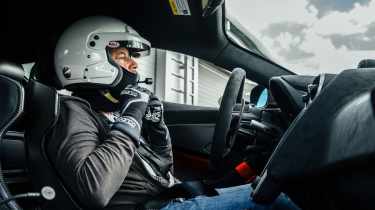McLaren 620R (2018 – 2020) review – McLaren's ultimate road racer made the 600LT look soft
Based on McLaren’s 570S GT4 race car the new 620R claims to mix race car performance with road car usability.
If McLaren fatigue was a clinically recognised condition then by rights we should all be chronic sufferers by now. Such has been Woking’s prodigious output over the last few years it’s been hard to keep pace with all of its latest models – Sports Series, Super Series, Ultimate Series, C, S, GT, LT, Spider, Senna, Speedtail, Artura and W1. We’ve seen them all. And yet nothing before or since, has been anything quite like the 620R.
Ok, let me qualify that. Of course we’ve seen something very similar in the shape of the 570S, but the 620R was a new kind of McLaren – one with genuine racing pedigree. Given the McLaren name is one of the pillars of motor racing history this may seem a strange statement, but until the 620R came along, McLaren’s road cars were just that. Road cars. Albeit with extraordinary performance. With the 620R McLaren entered an exacting but brutally straightforward niche. One in which purity, capability, desirability and authenticity counted for everything.
We’ll come to the capability and desirability elements in a moment, but you only have to look at the 620R and glance through its hardcore specification to know it has the purity and authenticity to mix it with the very best. The final instalment in McLaren’s Sports Series before the all-new generation of cars come on stream next year, the 620R is the culmination of years of learning, and a car you sense the whole engineering team had been itching to do for ages.
In a nutshell, the 620R was a £250,000 limited-edition road-legal version of the 570S GT4 race car. Just 225 were built in 2020. Powered by McLaren’s ubiquitous 3.8-litre twin-turbo V8, the wick has been turned up to 611bhp and 457lb ft, making it the most powerful model in the Sports Series family. The aero package – with three-stage adjustment of the rear wing – develops 185kg of downforce at 155mph, while lower, stiffer coilover suspension features manually adjustable GT4 dampers, centre-lock wheels and optional slick tyres. A lightweight interior completes the headline changes, but there are myriad detail improvements throughout.
More reviews
Appropriately, McLaren’s media drive day at which we sampled the 620R featured road and track driving, the latter at Snetterton in Norfolk. A circuit favoured by race teams as a testing venue due to its blend of low, medium and high-speed corners, plus a decent straight and big braking areas, it’s a formidable place to drive a car as quick as the 620R. The road route wasn’t a classic, but it served to establish whether the 620R is too much of a headbanger to be habitable for more than 20 minutes, or if it’s focused but fun.
> McLaren Artura Spider 2025 review – Britain's Ferrari 296 rival just got a whole lot better
Race car liveries on road cars rarely seem to work, at least in my eyes, and the limited standard palette of McLaren Orange, Silica White or Onyx Black, complete with GT4 livery stripes, seems to cheapen the overall look of what is a very serious tool. Then again, perhaps this is deliberate, as McLaren Special Operations (MSO) will happily facilitate other body colours and detailing. For a small fee, naturally.
All is forgotten as soon as you grasp the underside of the door’s upper section, swing it up and drop yourself into the cockpit. There’s a lot of bare carbonfibre in here and not much else. It even sounds empty – a bit echoey, like your living room with no furniture in it. With no carpets or other soft trim there’s a real 360 Stradale vibe to the stripped-out ambience. The carbon ‘Senna’ seats almost seem to swallow you, strategically placed padding offering additional support and comfort.
There’s a six-point harness for track use, but also a regular inertia reel belt for road driving, plus natty grab straps attached to the door handles, and a new rear-set centre console designed so that you can reach all the major switches when locked in place by the race harness. Both are neat and knowing touches. McLaren’s V8 has never been the most melodic, but there’s a gritty, industrial tone to the 620R that’s reminiscent of the P1. Some of the carbon trim gets agitated by the frequency of the resonant idle, zizzing and vibrating with nervous energy, as though the car just wants to get on with it.
In the last few years McLaren really has gotten to nail the feel and character of its cars. The 600LT was a particular highlight, but the 620R shades it for control weights, response rates and an immediate sense of connection. It really does feel like an event driving this car on the road, what with the firmness of the damping and directness of the steering. You know you’re in something special as soon as it turns a wheel.
> The McLaren 620R LM25 is an F1 GTR-inspired special
While there’s a welcome physicality to the controls there’s a palpable sense of lightness to the car itself. With a kerb weight of 1386kg and the tight control of those multi-adjustable dampers even small steering inputs are met with an immediate, pin-point accurate response.
For the road, the 620R runs on super-aggressive Pirelli P Zero Trofeo Rs, which key into the tarmac like running spikes. Activate the driver-selectable powertrain modes and the car really begins to wake up, thanks to even sharper throttle response and an ignition cut on upshifts that results in a single, savage rifle-shot crack with every high-rev, wide-throttle upshift. The rifle analogy isn’t a bad one, actually, for aside from adding precise, percussive punctuation points to your ballistic progress, it seems to underline the marksman-like accuracy with which you can place the 620R on the road. It really does have an uncanny ability to go exactly where you point it.
Where a 600LT has a slightly loose, playful feeling from the rear when you’re really working it hard with the stability control relaxed, the 620R is nailed to the road. It feels incredibly agile yet absolutely stable, the sensation of grip and lateral force drug-like in its potency. McLaren’s seven-speed seamless-shift gearbox is retained and the company’s inertia-push technology is also available that takes the built-up energy from the flywheel to provide a torque burst during upshifts.
Normally I’d question the point of such on-road capability, as it requires brain-out commitment to access, but thanks to the 620R’s more generous and, yes, noisier and less refined delivery, your enjoyment comes from the overall experience rather than purely from the pace at which you can travel. If anything you feel less need to go crazy.
> The £2m McLaren W1 is a 1257bhp successor to the P1
Some of this fun comes from the optional roof scoop intake, which feeds cold air down into the engine’s throat. Much like the P1 it generates all kinds of whooshes and gurgles – a cross between Airwolf and Darth Vader with a head cold – as you play the throttle and turbo boost builds. It adds intrigue to an aggressive, but otherwise workmanlike soundtrack, much of which tends to get drowned out by general road noise, especially on coarse surfaces. This is not a car that fosters conversation with your passenger, and renders the no-cost option of a hi-fi somewhat useless.
Considering paddleshift transmissions deny you so much in the way of operational inputs and required driving technique, it’s surprising how satisfying the McLaren’s gearbox is to use. The push-pull rocker arrangement offers something in the way of options when it comes to up and downshifts, and the feel of the switch is deliciously mechanical, accompanied as it is by a positive click for added satisfaction. Meanwhile McLaren’s Inertia Push technology, which harnesses built-up flywheel energy to give an extra burst of torque on upshifts, contributes to a transmission that’s arguably the most impressive of all the double-clutch ’boxes out there, including Ferrari’s.
The final piece of the puzzle is the brakes. You might expect and even forgive brakes with feel and response slightly compromised for road use so they perform best on track, at least in a car with the 620R’s singularity of purpose, but the carbon-ceramics have both bite and progression that works at road speeds and with reasonable pedal pressure. It adds up to an on-road experience that’s intense, sensorially overwhelming, but far from unpleasant or intolerable. A four-wheeled shot of espresso, if you like.
Returning to Snetterton with a pretty clear picture of the 620R’s memorably hardcore on-road demeanour, it’s time to switch into one of the track-prepared examples. Fitted with the slicks – made specially by Pirelli to fit the 620R’s 19 and 20-inch rims – and with the rear wing adjusted to the middle of its three angles (the wing on the road route car was fully trimmed out) and the dampers set with a dozen or so extra clicks for bump and rebound over the five or so dialled in for the road, it’s in what McLaren claims is the optimum set-up for Snett. McLaren also has a number of its factory GT drivers on hand to ride shotgun during our track sessions, both to provide instruction and as an insurance policy to try to ensure as many 620Rs return to the pitlane as leave it. Lucky them.
Racetracks have a habit of sucking the sensation of speed from all but the quickest road cars, but accelerating out onto Snetterton’s start-finish straight the 620R feels mighty. A polite reminder from my assigned instructor – 570S GT4 driver in British GTs Euan Hankey – that we need to get some temperature into the slicks is timely, as my head is still in road car mode. This quickly changes as I get more familiar with the car and the circuit as many months of lockdown rust rapidly get removed.
There’s an initial adjustment period required, partly to build confidence in the rising grip levels as the slicks start to switch on, and then in feeling where the limits are. It highlights just how within itself the 620R remains on the road, where understeer (and indeed, oversteer) is simply non-existent. After a few laps on track you begin to establish where the limits are in terms of turn-in grip and corner exit traction, and to acknowledge whether you’re struggling for mid-corner bite because you’ve turned in too early, or if you’re on an accurate trajectory and genuinely finding the limit.
Such are the 620R’s capabilities you soon forget you’re driving a road car. That’s hard on the car because you occupy a very different headspace when you’re driving – or think you’re driving – a race car. Instead of enjoying the feel and feedback, and maybe savouring the occasional opportunity to hold full throttle through a couple of the intermediate gears, you’re wringing its neck. You want more grip and stronger traction. You hammer the brakes, curse under your breath when you miss an apex and you always, always want more power.
What happens in the 620R is different, though. It ups its game as you raise yours. It’s ridiculously good fun. Especially when Hankey decides – perhaps foolishly – that I’m not going to kill him, and relaxes the stability control to its least intrusive setting. Immediately there’s more to do in terms of throttle modulation and steering correction, but there’s also a greater degree of freedom and a meaningful uplift in pace. By the time we near the end of our second track session I’m consistently seeing Hankey’s foot pushing an invisible brake pedal at the end of the straight. This useful onboard telemetry tells me I probably ought to calm down a bit, so we do a cool-down lap and return to the pits. Whatever McLaren pays these guys, it’s not enough.
Outright pace compared to the 570S GT4? Well, McLaren reckon there’s very little in it when running on slicks, with the Trofeo R road tyres adding around three seconds to an average-length lap. It’s worth mentioning that the 570S GT4 race car has its motor wound back to somewhere around 450bhp in order to balance its performance with less exotic class rivals. But considering it’s also running considerably lower and stiffer than the 620R, and wears the stickier race compound slicks used in the British GT Championship, that’s a pretty remarkable performance from a road-legal car.
All in all, then, the 620R is a rather sensational thing. Niche, yes, but the distinction between offering a slightly toned-down race car rather than another amped up road car is one that resonates with a certain type of enthusiast. Your humble scribe included. It’s a fitting finale to the era of Sports Series cars, ahead of the Artura's hybrid era, and a road racer of a calibre fit for comparison with the absolute best.
This story was first featured in evo issue 278.







